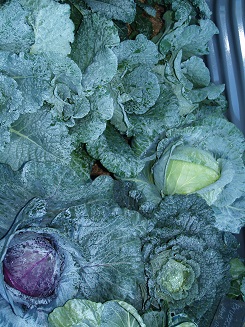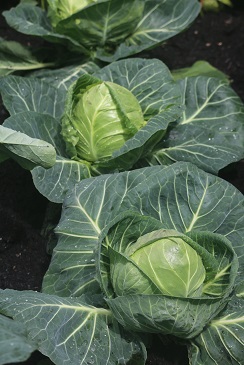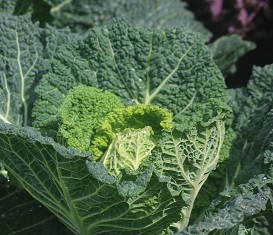How to Grow Cabbage
 Cabbages are one of several ‘cole’ crops, or cruciferous vegetables, which all belong to the genus Brassica, and the family Brassicaceae. Other members of this group include Brussels sprouts, broccoli, kohlrabi and kale.
Cabbages are one of several ‘cole’ crops, or cruciferous vegetables, which all belong to the genus Brassica, and the family Brassicaceae. Other members of this group include Brussels sprouts, broccoli, kohlrabi and kale.
Cabbages have improved greatly over the past few decades with many of the newer varieties having more subtle flavours than those of the past. They are full of fibre and a rich source of vitamins and better tasting, newer varieties and ever-expanding culinary uses have seen cabbages come back into favour. They are one of the most versatile crops to grow over the cooler months.Cabbages are adaptable to a variety of climates, but it is important to sow the correct variety for the area, and for the time of year. In warmer climates they are grown all year, in temperate and cooler regions they are best grown from spring to autumn, once the danger of frosts is over.
Culture
Cabbage (like all brassicas) is subject to some serious nutrient disorders good soil preparation and strict crop rotation will usually avoid these problems. Cabbages can be grown in most soils well enriched with organic matter.
Although you can grow cabbages in any soil so long as it is free-draining - cabbages which remain in the soil over winter for spring harvesting need a lighter soil. You can improve soils by digging in some well-rotted manure a couple of months before planting. All cabbages will thrive if their growing conditions remain unchanged. That is, they like continuous moisture, a ready supply of nutrients and plenty of air and sunlight. They grow best if temperatures above 13°Celsius are maintained at all times. If your crops are going to be in the ground over summer or winter look for non-bolting varieties which can withstand extremes of temperature without going to seed. Cabbages also grow remarkably well in hydroponic systems, particularly in aggregate culture.
- Provide good drainage.
- Constant moisture is important.
- Prefers loose, cultivated soil. In heavy soils dig in lots of compost/organic matter.
- For most varieties, temperatures should be above 13°C for optimum growth. There are varieties that will grow at lower temperatures over winter.
- Crop rotation (at least every two years) and good soil preparation will help prevent nutrient disorders.
- Mulch with well-decomposed manure and organic mulch
- Apply seaweed or liquid manure fertilizers throughout the crop
- Avoid close cultivation.
Planting
 Cabbages are usually sown from seeds under glass or in a greenhouse. The young seedlings are then pricked out into trays and when strong enough these are placed in a cold frame to harden them off.
Cabbages are usually sown from seeds under glass or in a greenhouse. The young seedlings are then pricked out into trays and when strong enough these are placed in a cold frame to harden them off.
These are then set out in the soil when they have five to six leaves, and spaced at about 30cm to 50 cm apart in rows according to the ultimate size of the plants.
- Don't plant them too close together otherwise they will compete for nutrients and may not get enough sunlight.
- Try to keep as much soil as possible around the seedling roots when transplanting and firm the soil around the roots when in position.
When grown from seed, cabbages can take anything from 10-11 weeks to reach maturity for early types through to five or six months for later types. Seedlings take less time and can be anything from 8 weeks to three or four months.
You can sow seed or plant seedlings all year in some areas by choosing appropriate cultivars. When you sow the seeds will very much depend on when you want your cabbages ready to eat. For instance, autumn sown ones should be ready in spring. Spring sown crops should be ready to harvest from late summer through to winter (depending on the variety). If planting in autumn, aim to plant seedlings 6 weeks or so before the first frost and they should be hardy enough as the weather cools. If planting in spring you'll want your plants to be mature enough before the warmest weather starts.
In cool to cold areas such as the UK or Tasmania:
Spring cabbage varieties are usually sown in late summer and transplanted early to mid -autumn.
Summer cabbages varieties are sown from late winter to very early to late spring (under cloches) and transplanted late spring to early summer.
Winter cabbages are sown in mid to late -spring and transplanted late summer.
- Sow seed direct (in temperate areas) and thin out, or plant seedlings as described above.
- Smaller varieties should be spaced 30 x 30 cm apart.
- Larger varieties will need to be spaced 45 x 45 cm apart.
- Plant in raised (mounded) soil beds to aid drainage.
Water and Nutrient Requirements
In well prepared soils cabbages should find all the nutrients they need. If growth is slow, cabbages respond well to supplements of nitrogen, phosphorus and iron. A liquid feed for vegetables should cater for these needs and can be applied fortnightly. Cabbages grown through winter should not be given supplementary feeding.
The ideal soil pH is 6.5. Adding lime to the soil during preparation may be necessary to bring the soil into this range if it is too acidic. If you are unsure of your soil pH it's probably worth investing in a soil test kit and checking. Water your cabbages to keep the soil moist, and apply a layer of organic mulch such as bark chips to help retain soil moisture. Try not to let the soil become too wet or too dry. Raised mounds are a good option in overly wet soils. Once cabbages start to mature, water them less frequently to avoid splitting.
- Nitrogen, phosphorus and iron are particularly important. Iron and boron are also important. Routine sprays with liquid seaweed fertiliser may be beneficial.
- Has a higher than average boron requirement.
- The ideal pH is 6.5 (but can vary a little below and above this).
- Apply seaweed or liquid manure fertilisers throughout the crop and use organic mulches.
- Moist but well-drained soil.
Pest and Disease Problems
Cabbage white butterfly, caterpillars and grasshoppers may be problematic. Use garlic or pyrethrum sprays to control pests or exclusion fabrics as row covers. Club root disease can sometimes be a problem. Crop rotation and good fertility will usually overcome this problem.
Cabbage white and other butterfly grubs must be controlled. They tend to eat holes into leaves and may tunnel inside plants. Pick off and crush the odd ones. For infestations consider introducing the organic control, Bacillus thuringiensis (this may be under review for use in your country – you will need to check locally to view the current status).
Aphids can sometimes be a problem, particularly on young leaves. They may spread viruses to your plants and cause reduced vigour. Various eco oils can remove them.
Cabbage root fly maggots can invade the roots. The best protection is to keep them out; mulch or cardboard discs around the base of plants may be helpful. Exclusion fabric over the seedlings will prevent flies laying the maggots in the soil. Crop rotation is important as maggots can over-winter to emerge in spring as flies triggering another cycle.
Flea beetles can also be problematic. Control these by regularly hoeing the soil to destroy eggs and larvae, and water regularly.
Probably the worst disease of cabbages is club root. This results in distorted roots and stunted growth. The disease is spread by fungal spores. Practicing crop rotation can limit the risk, as can reducing soil acidity with lime.
Damping off may kill seedlings and there is little you can do if it takes hold. Avoid overwatering them and keep all propagating equipment sterile.
Cabbages can be attacked by several other fungal diseases including fusarium, downy mildew, and alternaria leaf spot. Use of (approved for use) proprietary fungicides may be required if outbreaks are significant. Crop rotation and removal of infected plants is important.

Harvest
You can harvest winter cabbages when you need them. Unlike some other crops which must be harvested within days of maturing, these cabbages can be cut early as smaller heads, or left for weeks after maturity and cut later when needed.
Those maturing in spring and summer are best harvested when they reach maturity. That is, when the heads are large and firm. If heads begin to split when still in the ground they should be harvested to avoid insect damage. Cut the cabbages from the roots with a sharp knife. Dig out roots and compost them except if they have maggots or diseases in which case they should be destroyed.
Harvested cabbages can be stored for a month or more after harvest in cold storage at 0 to 3° Centigrade and low relative humidity. If wrapped in cling film and stored in the fridge they should last a couple of weeks.
- Smaller, early varieties can be harvested in about 8 - 10 weeks, larger later varieties in about 12 - 14 weeks. 6-12 plants per planting will feed the average family.
- Cut through the base with a sharp knife when the centre is large and firm. Remove outer leaves.
- Harvested cabbages can be stored for a month or more after harvest at 0 to 3 degrees Celsius and low relative humidity.
You may also be interested in....